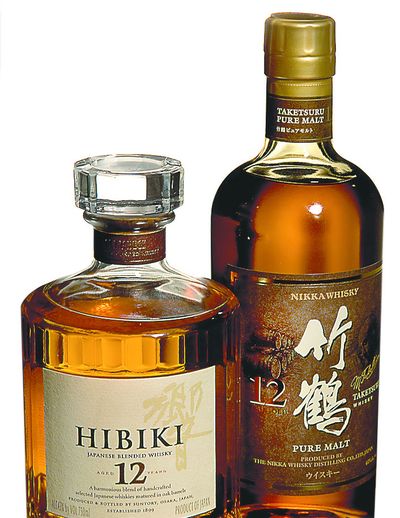Japan’s whiskies follow Scottish roots
Varieties increasingly available to U.S. fans

Much of the world, including the United States, spells whiskey with an “e.” The Scottish do not. On those salty, green cliffs, they drink whisky.
The Japanese also drink whisky, and there’s a simple reason for that: when its whiskey industry was taking root nearly 100 years ago, it was largely influenced by the genius that is Scotch whisky. One of the forefathers of Japanese whisky, Masataka Taketsuru, studied distilling in Scotland before launching Nikka, one of the country’s two major whisky manufacturers.
Decades later, the whisky student is close to besting the whisky master.
In recent years, Japanese whiskies have regularly bested their Scotch counterparts at Whisky Magazine’s World Whiskies Awards. The single malt honored as the world’s best last year wasn’t made in Scotland – it was Yamazaki 25 year old.
“In a blind tasting, a Scotch enthusiast wouldn’t be able to distinguish between the two,” said John Hansell, editor and publisher of Whisky Advocate.
Heresey to Scotch enthusiasts, perhaps, but Japanese whisky is ascendant, particularly in the U.S., where the available varieties will more than double by year’s end.
Japanese whisky in this country has traditionally been limited to one company – Suntory, which film fans might recall was the distillery that Bill Murray’s character traveled to Japan to endorse in the movie “Lost in Translation.”
Late last year, Nikka – its chief rival – started importing two brands into this country. Four more will follow in the coming months. That will total about 10 Japanese whiskies in the U.S. Other brands, including craft, are likely to follow.
Early adopters have taken to it for both its novelty and quality, but the industry sees ample opportunity for growth.
As David King, president of Anchor Distilling, which imports Nikka, said, if he had announced 20 years ago that an Irish whiskey named Jameson would be as popular in the U.S. as it is today, “they’d say don’t be so bloody stupid.”
“But Jameson is easy to drink, mild and good quality,” King said. “I can see at some stage Japanese whiskey could be the next Irish.”
Japanese whiskies largely aren’t pushing boundaries; what’s available in the U.S. are clean, well-executed single malts and blends, some of which are peat-forward as some Scotches are. Most are aged in used Scotch and bourbon barrels, with the rare use of Japanese oak.
“They seem to have the art of blending,” King said. “I don’t know if it comes from their history with tea or sake, but they have an innate ability to blend.”
Three to try:
Yoichi Single Malt (15 year old): A highly-regarded and elegant mix of smoke, tobacco, wood and brine. $120
The Hakushu (12 year old): Heavily peated for a Japanese whisky. Find this, Scotch fans. $60
Hibiki (12 year old): Accessible and easy to drink, this blend is a nicely rounded, complex web of fruit, toffee and wood. $65